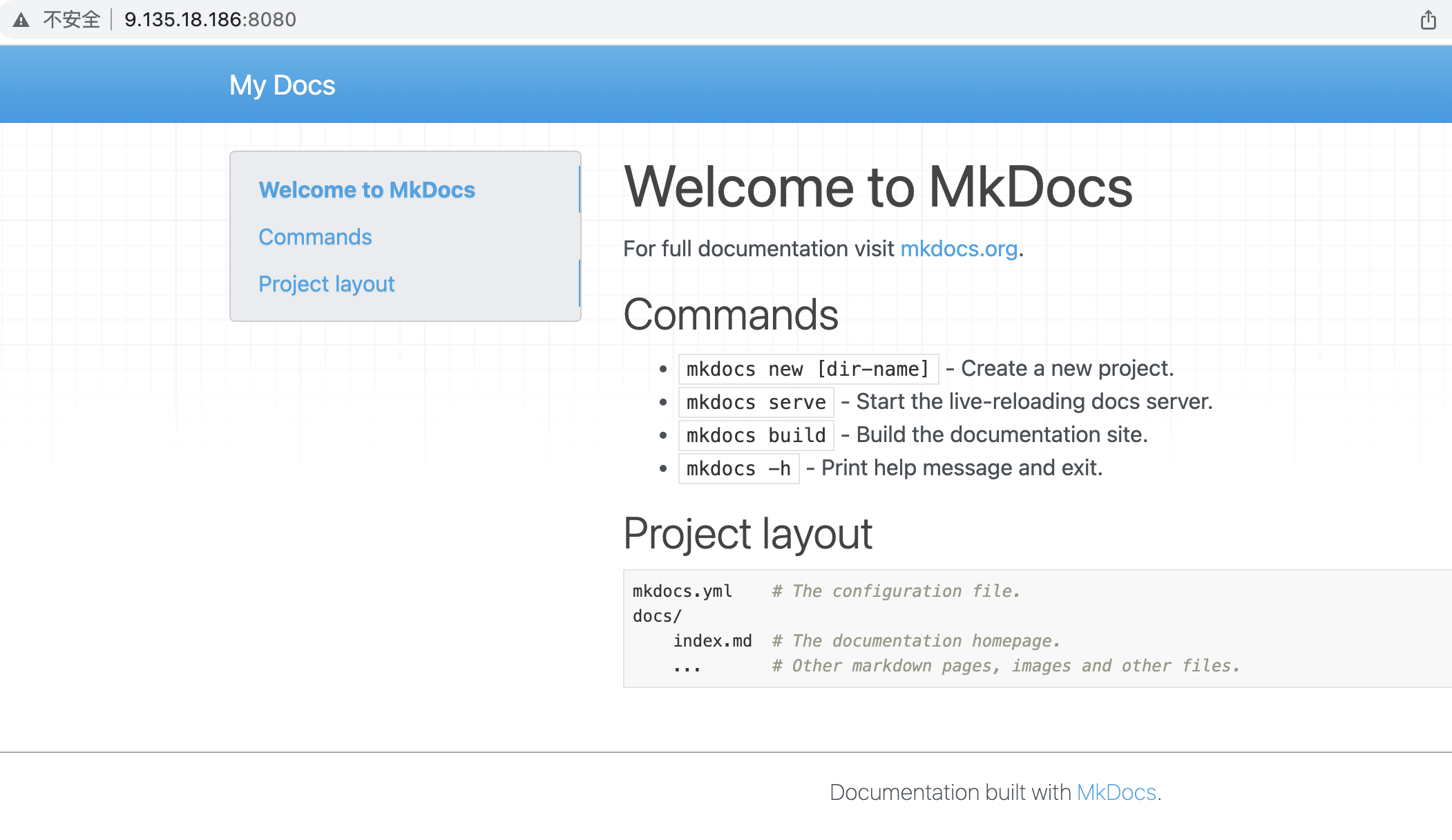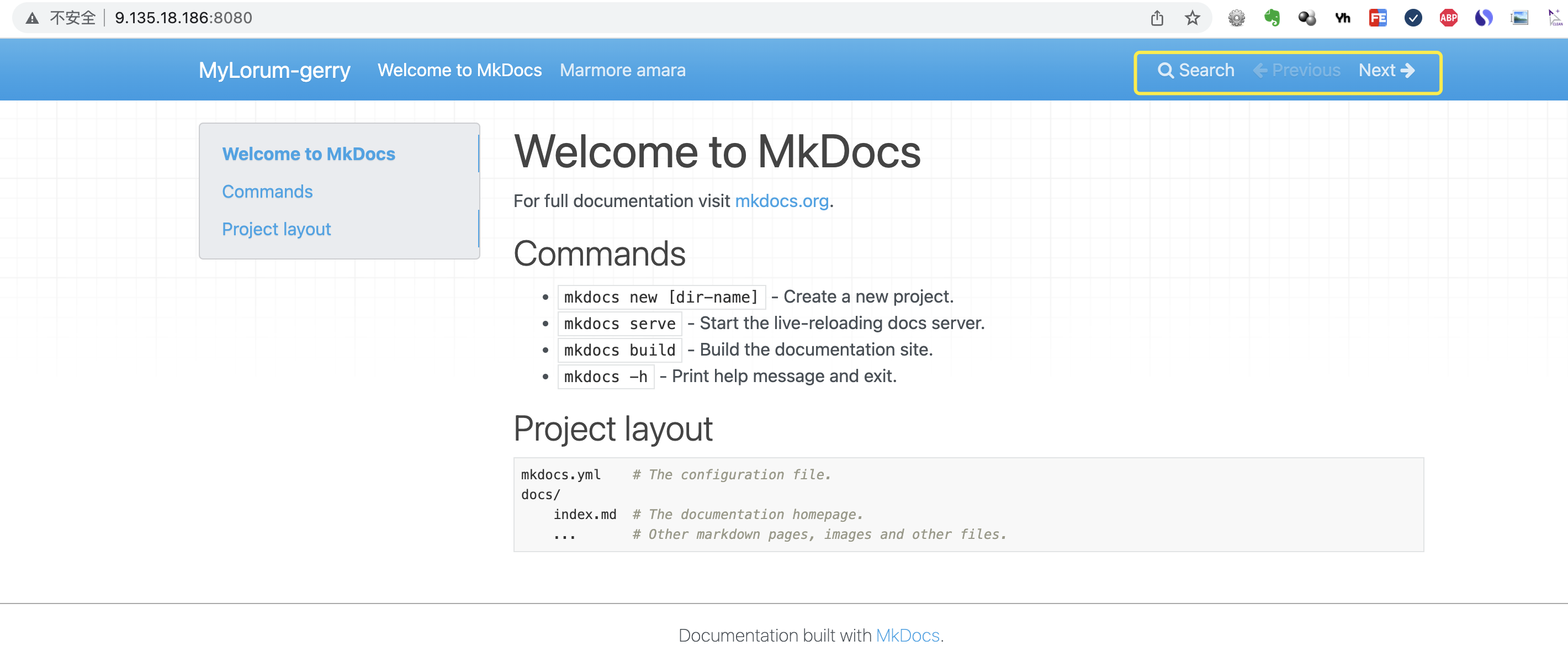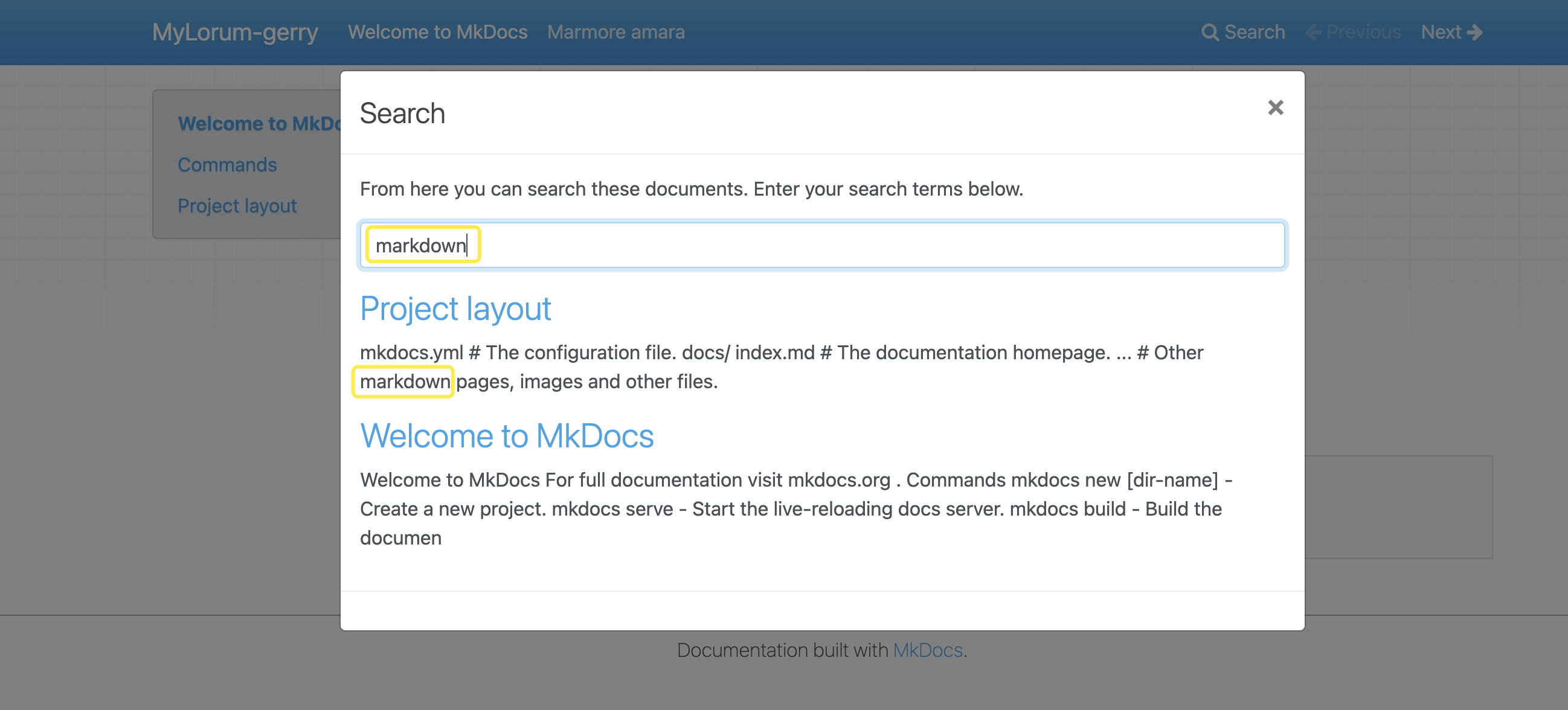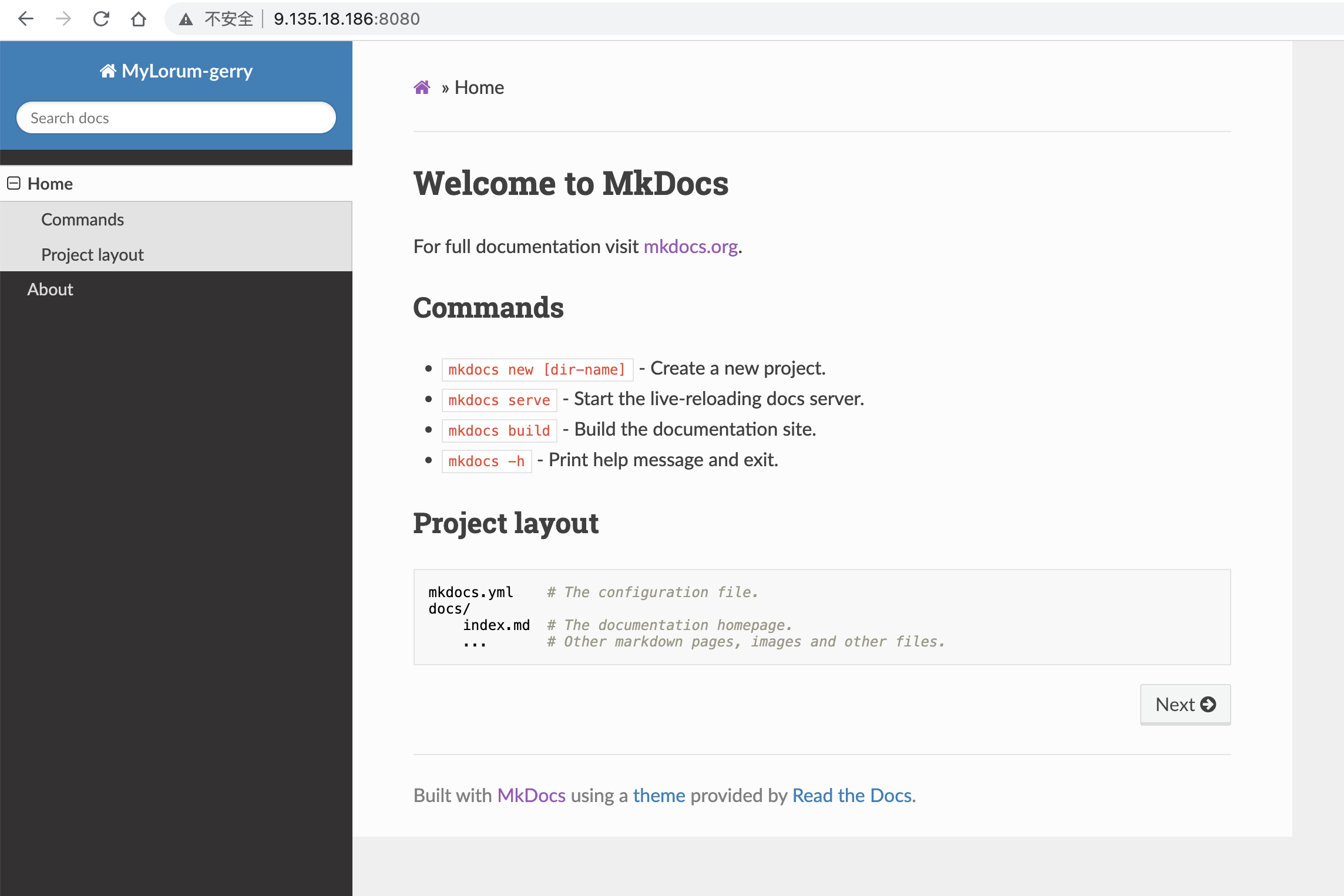MkDocs in Action
Project documentation with Markdown.
MkDocs is a fast, simple and downright gorgeous static site generator that’s geared towards building project documentation. Documentation source files are written in Markdown, and configured with a single YAML configuration file. Start by reading the introductory tutorial, then check the User Guide for more information.
Features:
- Great themes available
- Easy to customize
- Preview your site as you work
- Host anywhere
For full documentation visit mkdocs.org.
Commands
mkdocs new [dir-name] - Create a new project.
mkdocs serve - Start the live-reloading docs server.
mkdocs build - Build the documentation site.
mkdocs -h - Print help message and exit.
Project layout
mkdocs.yml # The configuration file.
docs/
index.md # The documentation homepage.
... # Other markdown pages, images and other files.
Getting Started with MkDocs
Installation
pip install mkdocs
Creating a new project
mkdocs new my-project
cd my-project
~/tools/mkdocs$mkdocs new my-project
INFO - Creating project directory: my-project
INFO - Writing config file: my-project/mkdocs.yml
INFO - Writing initial docs: my-project/docs/index.md
~/tools/mkdocs$ls
my-project
~/tools/mkdocs$tree my-project/
my-project/
├── docs
│ └── index.md
└── mkdocs.yml
1 directory, 2 files
There’s a single configuration file named mkdocs.yml, and a folder named docs that will contain your documentation source files (docs is the default value for the docs_dir configuration setting). Right now the docs folder just contains a single documentation page, named index.md.
MkDocs comes with a built-in dev-server that lets you preview your documentation as you work on it. Make sure you’re in the same directory as the mkdocs.yml configuration file, and then start the server by running the mkdocs serve command:
$mkdocs serve -a 9.135.18.186:8080
INFO - Building documentation...
INFO - Cleaning site directory
INFO - Documentation built in 0.11 seconds
INFO - [20:21:41] Watching paths for changes: 'docs', 'mkdocs.yml'
INFO - [20:21:41] Serving on http://9.135.18.186:8080/
INFO - [20:21:47] Browser connected: http://9.135.18.186:8080/
INFO - [20:22:41] Browser connected: http://9.135.18.186:8080/
INFO - [20:25:15] Browser connected: http://9.135.18.186:8080/
INFO - [20:30:35] Detected file changes
INFO - Building documentation...
INFO - [20:30:35] Reloading browsers
INFO - [20:30:35] Browser connected: http://9.135.18.186:8080/
Open up http://9.135.18.186:8000/ in your browser, and you’ll see the default home page being displayed.

The dev-server also supports auto-reloading, and will rebuild your documentation whenever anything in the configuration file, documentation directory, or theme directory changes.
Open the docs/index.md document in your text editor of choice, change the initial heading to MkLorum, and save your changes. Your browser will auto-reload and you should see your updated documentation immediately.
Now try editing the configuration file: mkdocs.yml. Change the site_name setting to MkLorum and save the file.
site_name: MkLorum
site_url: https://example.com/
Your browser should immediately reload, and you’ll see your new site name take effect.
Note:
The site_name and site_url configuration options are the only two required options in your configuration file. When you create a new project, the
site_urloption is assigned the placeholder value:https://example.com. If the final location is known, you can change the setting now to point to it. Or you may choose to leave it alone for now. Just be sure to edit it before you deploy your site to a production server.
Adding pages
Now add a second page to your documentation:
curl 'https://jaspervdj.be/lorem-markdownum/markdown.txt' > docs/about.md
As our documentation site will include some navigation headers, you may want to edit the configuration file and add some information about the order, title, and nesting of each page in the navigation header by adding a nav setting:
site_name: MkLorum
site_url: https://example.com/
nav:
- Home: index.md
- About: about.md
Save your changes and you’ll now see a navigation bar with Home and About items on the left as well as Search, Previous, and Next items on the right.

Try the menu items and navigate back and forth between pages. Then click on Search. A search dialog will appear, allowing you to search for any text on any page. Notice that the search results include every occurrence of the search term on the site and links directly to the section of the page in which the search term appears. You get all of that with no effort or configuration on your part!

Theming our documentation
Now change the configuration file to alter how the documentation is displayed by changing the theme. Edit the mkdocs.yml file and add a theme setting:
site_name: MkLorum
site_url: https://example.com/
nav:
- Home: index.md
- About: about.md
theme: readthedocs
Save your changes, and you’ll see the ReadTheDocs theme being used.

Changing the Favicon Icon
By default, MkDocs uses the MkDocs favicon icon. To use a different icon, create an img subdirectory in the docs directory and copy your custom favicon.ico file to that directory. MkDocs will automatically detect and use that file as your favicon icon.
Building the site
That’s looking good. You’re ready to deploy the first pass of your MkLorum documentation. First build the documentation:
mkdocs build
This will create a new directory, named site. Take a look inside the directory:
$ ls site
about fonts index.html license search.html
css img js mkdocs sitemap.xml
~/tools/mkdocs/my-project$mkdocs build
INFO - Cleaning site directory
INFO - Building documentation to directory: /data/home/gerryyang/tools/mkdocs/my-project/site
INFO - Documentation built in 0.10 seconds
~/tools/mkdocs/my-project$ls
docs mkdocs.yml site
~/tools/mkdocs/my-project$cd site/
~/tools/mkdocs/my-project/site$ls
404.html about css img index.html js search search.html sitemap.xml sitemap.xml.gz
Notice that your source documentation has been output as two HTML files named index.html and about/index.html. You also have various other media that’s been copied into the site directory as part of the documentation theme. You even have a sitemap.xml file and mkdocs/search_index.json.
If you’re using source code control such as git you probably don’t want to check your documentation builds into the repository. Add a line containing site/ to your .gitignore file.
echo "site/" >> .gitignore
If you’re using another source code control tool you’ll want to check its documentation on how to ignore specific directories.
Other Commands and Options
There are various other commands and options available. For a complete list of commands, use the --help flag:
mkdocs --help
To view a list of options available on a given command, use the --help flag with that command. For example, to get a list of all options available for the build command run the following:
mkdocs build --help
Deploying
The documentation site that you just built only uses static files so you’ll be able to host it from pretty much anywhere. Simply upload the contents of the entire site directory to wherever you’re hosting your website from and you’re done. For specific instructions on a number of common hosts, see the Deploying your Docs page.
Getting help
See the User Guide for more complete documentation of all of MkDocs’ features.
To get help with MkDocs, please use the GitHub discussions or GitHub issues.
Other Tools
- https://obsidian.md/